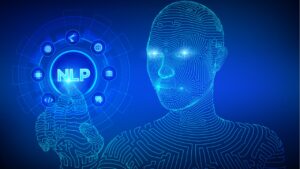
Natural Language Processing, or NLP, is about teaching machines to understand human language. Machines can’t understand words and sentences naturally like humans can. With NLP, machines can learn the rules of language. This lets them read, understand, and even write text. NLP uses machine learning algorithms that are trained on lots of text data. By taking an Online Machine Learning Course, you can learn how NLP works step-by-step. Understanding NLP helps machines communicate with humans using language.

Alt Text- > Natural Language Processing (NLP): The Language of Machines
Table of Contents:
- Introduction to Natural Language Processing (NLP)
- Evolution of NLP: From Rule-based Systems to Deep Learning
- Key Concepts in NLP: Tokenization, Lemmatization, and POS Tagging
- NLP Applications: Sentiment Analysis, Named Entity Recognition, and Machine Translation
- Challenges in NLP: Ambiguity, Context, and Cultural Nuances
- NLP and Machine Learning: A Synergistic Relationship
- Ethics and Bias in NLP: Addressing Fairness and Privacy Concerns
- Future Trends in NLP: Advancements and Opportunities
- NLP in Action: Case Studies and Real-world Examples
- Conclusion: Harnessing the Power of NLP in the Digital Age
Introduction to Advanced Data Science Techniques
Data science is a broad field encompassing many techniques and algorithms for extracting insights from data. While basics like data cleaning, visualization, and machine learning provide a solid foundation, truly mastering data science requires diving into more advanced methods.
In this blog post, we will explore some of the most important advanced data science techniques using Python. These include feature selection, ensemble learning, neural networks, unsupervised learning, time series analysis, natural language processing, reinforcement learning, and big data analytics. Mastering these advanced techniques will allow you to build highly accurate models and derive deep insights from complex data.
Feature Selection and Dimensionality Reduction
Real-world datasets often contain a huge number of features or variables. Many of these features may be irrelevant or redundant for the machine learning task at hand. Feature selection techniques allow you to identify and select the most relevant features for inclusion in your model. This improves model performance and interpretability by eliminating noise.
Useful Python libraries for feature selection include scikit-learn, pandas, and numpy. Techniques like variance thresholding, correlation analysis, recursive feature elimination, and principal component analysis can help identify the best feature subsets. Dimensionality reduction is closely related and aims to consolidate predictive power into fewer variables.
Ensemble Learning: Combining Models for Better Results
Ensemble methods allow you to combine multiple machine learning models into one predictive model in order to decrease variance (bagging), bias (boosting), or improve predictions (stacking). Popular Python ensemble libraries include scikit-learn, XGBoost, LightGBM, and catboost.
Bagging algorithms like random forest and ExtraTrees build multiple models on randomly sampled subsets of the data then average out their predictions. Boosting methods like AdaBoost, GradientBoosting, and XGBoost train models sequentially, focusing on errors from prior models. Stacking trains a meta-model to combine the outputs from multiple base models.
Ensembles generally outperform single models. Combining different types of models can further improve accuracy and robustness.
Neural Networks and Deep Learning
Neural networks have exploded in popularity due to their state-of-the-art performance on complex problems like image recognition, natural language processing, and forecasting. The key advantage of neural nets is their ability to learn highly complex and non-linear relationships within the data.
Python has fantastic libraries for building and training neural networks like Keras, PyTorch, and Tensorflow. When developing neural nets, key steps include choosing an appropriate architecture (number of layers, neuron types, connections), loss functions, and optimizers. Deep learning requires very large training datasets and significant computing power. The results can be remarkable if configured and tuned properly.
Unsupervised Learning: Clustering and Anomaly Detection
Most machine learning focuses on supervised learning, where the model learns from labeled examples. Unsupervised learning aims to detect patterns in data without labels. This can uncover hidden structure and groupings within complex data.
Python provides many libraries for unsupervised learning. Key techniques include clustering algorithms like k-means and hierarchical clustering which group similar data points together. Anomaly detection identifies outliers that are distant from other observations. Dimensionality reduction (e.g. PCA) also falls under unsupervised learning in Python.
Time Series Analysis and Forecasting
Time series data is extremely common, found in domains like finance, economics, meteorology, and energy. Time series analysis techniques make it possible to model sequential data to understand patterns and make forecasts.
Python offers powerful libraries for time series tasks. When modeling time series data, techniques like moving averages, decomposition, and ARIMA modeling allow you to smooth out noise, identify trends and seasonalities, and make accurate future projections. Facebook’s Prophet library is purpose-built for time series forecasting using intuitive parameters.
Natural Language Processing (NLP) in Depth
Natural language processing or NLP enables computers to extract meaning from text and speech data using machine learning. This powers applications like machine translation, speech recognition, and sentiment analysis. Python has excellent NLP libraries, including spaCy, NLTK, gensim, and neural network frameworks like Keras.
Key NLP techniques include language modeling, word embeddings, entity recognition, translation, classification, and topic modeling using algorithms like word2vec, LSTM networks, transformers, and latent Dirichlet allocation. Pretrained language models like BERT and GPT-3 have driven great advances in NLP.
Reinforcement Learning: Training Agents to Make Decisions
Reinforcement learning teaches AI agents to take optimal actions to maximize rewards from their environment through trial and error. It has achieved impressive results in complex games like chess, Go, and Dota 2. Python libraries for reinforcement learning include OpenAI Gym, Ray, and Coach.
In reinforcement learning, the agent continuously interacts with the environment, receiving rewards for good decisions and punishments for bad ones. Q-learning and policy gradient methods are popular algorithms. Deep reinforcement learning combines deep neural networks with reinforcement learning for enhanced performance.
Big Data Analytics with Python
As data volumes grow ever larger, applying data science techniques at scale requires big data tools. The PyData stack (pandas, NumPy, etc) integrates nicely with big data platforms like Apache Spark, Hadoop, and Dask. These make it possible to analyze huge datasets that won’t fit in memory using distributed, streaming computation.
Beyond big data infrastructure, key techniques for large-scale data analysis include algorithms like Stochastic Gradient Descent that can be parallelized across nodes. Feature hashing helps compactify sparse high-dimensional data into usable features. Data lakes and data warehouses store vast amounts of data for on-demand analytical querying.
Conclusion: Mastering Advanced Data Science Techniques
This overview highlights some of the many advanced data science techniques available in Python that allow practitioners to derive enhanced insights from ever-growing diverse datasets. From complex neural networks, to reinforcement learning, to highly scalable algorithms, these cutting-edge techniques represent an evolved and expanded toolkit for advanced data science.
Becoming proficient in these advanced methods involves studying their mathematical foundations, gaining experience applying them through Python on sample problems, and keeping up with latest developments. Mastering these techniques takes significant practice and effort, but enables you to maximize the potential of data science, unlocking deeper knowledge from data at scale. The possibilities to learn from and understand complex systems are tremendous.
Author Profile

- Gaurav Kanabar serves as the Chief Technologist for Digital Content and Platforms at Luckymatrix. Alongside his role at Luckymatrix, Gaurav is CEO of Alphanso Technology, an India-based web and app development company developing an Event management system in PHP and open-source streaming software for helping entrepreneurs, independent artists, and more.
Latest entries
 Digital MarketingApril 8, 2025Manage your website smartly with VPS Servers in Germany
Digital MarketingApril 8, 2025Manage your website smartly with VPS Servers in Germany SoftwareApril 3, 2025Maximize Your Efficiency & Save Time With Free Invoice Software
SoftwareApril 3, 2025Maximize Your Efficiency & Save Time With Free Invoice Software Digital MarketingApril 3, 2025Why Social Media Platforms Benefit from File Upload Features
Digital MarketingApril 3, 2025Why Social Media Platforms Benefit from File Upload Features Digital MarketingApril 3, 2025Top 10 Best Video Animation Companies in Dubai, UAE
Digital MarketingApril 3, 2025Top 10 Best Video Animation Companies in Dubai, UAE